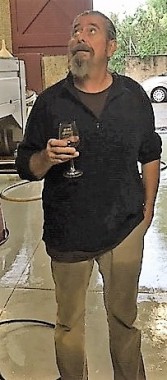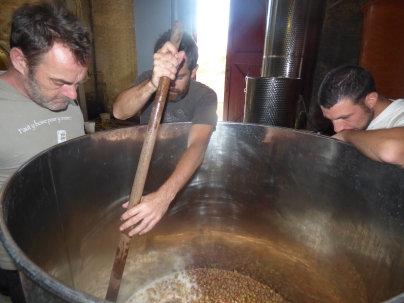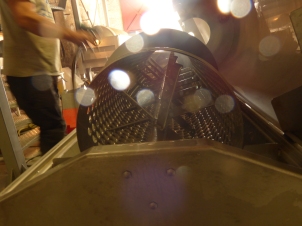Having talked about new varieties of grape planted at Jeff Coutelou’s domaine in Puimisson the last few days have been about a variety of different activities, vintages and grapes too. After the rain break on the 9th, we restarted on Friday 10th by spending the morning in the vineyards of Segrairals and Peilhan picking Cinsault and Carignan respectively.
The Cinsault often comes in large berries and bunches and, as a consequence, the open bunches can be prone to disease and ver de la grappe. As we picked, therefore, we took great care to conduct a triage on the spot leaving a lot of the grapes behind as you can see. To paraphrase the old John West advert, ‘It’s the grapes we reject that make Coutelou the best.’ Even in a year with much reduced quantity the emphasis has to be on quality, clean grapes if the wines are to be good.
Peilhan was quite badly hit by the April frost and the Carignan was particularly damaged. Some vines had no fruit, others still produced well. Again we sorted the grapes carefully in the vineyard. Both harvests went into the press directly. When grapes are not of the highest quality it is not worth destemming and fermenting separately as any taint will spoil the wine. Without the comfort blanket of SO2 Jeff wanted to get the juice from the grapes quickly, likely to produce rosé rather than red after spending so little time on skins extracting colour.
In the afternoon, the Moroccan pickers moved on to the Mourvèdre back in Segrairals. Meanwhile I and some of the team were given a different direction altogether. Jeff had selected some of the best white Macabeu grapes of 2019 for ageing in barrel, they had recently been moved to stainless steel tank in the white wine section of the cellar. The juice was run off the top of the tank and then the marc (skins, pulp, pips etc) were brought to the basket presses.


The Leaning Tower of Puimisson
Operating these presses was one of the first jobs Jeff gave me in 2014 and so I set about extracting more juice from the marc. The pressing must be light as the marc contains more tannins which might make the overall wine more bitter. It is surprising how much extra comes out of the marc, and even more surprising to see whole grapes still amongst it after 2 years. The final wine tasted great and I can’t wait to open a bottle and see how it develops further.
The following day, Saturday, brought more variety and a new job for me. Macabeu and Grenache Gris from Peilhan was brought to cellar and the first couple of rows of vines were sent to press. Jeff, however, decided that the rest was higher quality and wanted to use these grapes for fermenting and maturing in amphora. There have been 4 of these for a while now and Jeff is convinced they do improve the quality of some wines. However, he did not want anything but the grapes themselves in the amphora. Therefore, we used the égrappoir to destem the bunches but then had to pick through every grape to remove any remaining pieces of stalk or stem. Painstaking, meticulous work.
In the afternoon it was time to bring in the Grenache of La Garrigue. I identified this as the best parcel of the vintage in my first blog of this year’s vendanges, the grapes were of very high quality. You might recall that apparently this was hard hit last year and it was as if nature was offering compensation. The quality brought a smile to Jeff’s face and raised the morale of the whole team. The grapes went through the égraineur (which separates each berry not just the whole bunch like the égrappoir), and the juice already tasted especially good, confirmed by the technical analyses.
Monday 13th brought the longest and hardest day of the vendanges for me personally. It started in typical fashion with the remaining Grenache being sent to a separate tank for using with other wine. However, we then moved to the Carignan of Rec D’Oulette, the parcel which produces Flambadou in good years. Unfortunately, this is not a good year, unless you’re a fan of Grenache and white wines. Jeff decided that the Carignan should be made in whole bunch, carbonic maceration style. Instead of destemming the bunches, everything goes into tank and is protected by CO2 which also kicks off fermentation in the berries themselves.
That meant we set up sorting above the tank which would hold the grapes. On a hot, sultry day that meant working inside and above the rising heat from the grapes. Matteo and I spent the best part of six hours processing the Carignan, it was back breaking, sweaty work and tested this 62-year-old man but I made it through. Just.
From direct press to basket press, destemming single grapes to whole bunches, whites to reds and orange wine too, even grapes from an older vintage. This was a period of the vendanges which was all about variety.










































































































